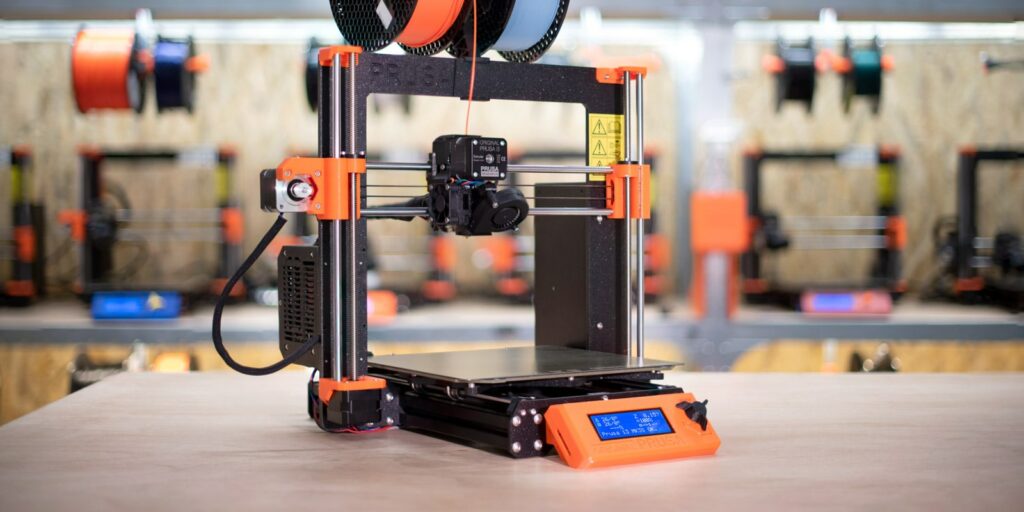There may be difficulties in finding a good printer. Don’t worry since we will mention what users prefer when looking for the best 3D printer for under $1000 in 2024. It is not easy to find and evaluate the quality of printers under 1000 on the market today.
Linquip’s website offers a wealth of information if you want to make an informed decision about 3d printers. We provide you with access to cutting-edge additive manufacturing and 3D printing tools so that you can perform your duties more efficiently. Depending on the intended use of Linquip, we explain what Linquip offers on our “What Is Additive Manufacturing and 3D Printing?” page.
Have you been thinking about buying a 3D printer? Linquip offers a broad selection of Additive Manufacturing and 3D Printing Products that can help you find the right product for your needs. You can receive quotes for 3D printers through Linquip’s platform. You can receive quotes quickly and easily from Additive Manufacturing and 3D Printing Companies and Suppliers using our online form.
Some 3D printers under $1000 fall in a sweet spot where they are ideal for hobbyists and semi-pros alike. They offer great value, great features, and a great combination of them all.
List of 10 Best 3D Printer for Under $1000 in 2024
According to the factors that we will mention in this article, Here is the List of 10 Best 3D Printer for Under $1000 in 2024:
- PRUSA Original Prusa i3 MK3S Buy Now
- ANYCUBIC Resin 3D Printer Buy Now
- R QIDI TECHNOLOGY 3D Printer Buy Now
- Digilab 3D20 3D Printer Buy Now
- BIBO 3D Printer Buy Now
- Official Creality Ender 3 S1 3D Printer Buy Now
- FlashForge 3D Printer Buy Now
- Creality CR10 S5 Buy Now
- Elegoo Saturn Buy Now
- MatterHacker Pulse XE Buy Now
3d Printer Buying Guide
3D printers are packed full of tech, including blistering-hot extruders, auto-leveling trays, WiFi, and 4K+ LCD panels to cure the liquid resin. Using the Bowden mechanism for filament channeling came from an important bicycle engineering invention. As a device with so many mechanical components and systems packed into a single device, 3D printers are inherently technical devices. As a result, you should be familiar with some aspects of how the technology works before you make a purchase.
The first functional 3D printer was built in the 1980s, but it did not reach the mass market until the 2000s. The first inventor who filed a patent for a 3D printer was Bill Masters, while a few scientists and inventors were concurrently developing technologies that would later be incorporated into today’s 3D printer systems.
This section provides a few evaluation criteria for newcomers to understand to help them choose a quality version.
Purpose of Use
It is essential to know what a 3D printer is intended for before you purchase one. What is your primary use for the printer? Is it for educational purposes, professional purposes, or just for fun? Are you planning on using your printer at home, at work, in your garage, or at school? Think about these questions before making a decision.
Beginners or those looking for a 3D printer for kids or educational purposes should put their main emphasis on ease of use and safety.
Alternatively, if you want a professional-grade printer that includes features like a heated bed, a high-temperature hot end, and dual extruders, you would be better off looking at a high-quality printer.
3D Printing Technology
There are vast differences in materials, setting up of machines, workflow, and applications between FDM and resin 3D printers.
FDM
With FDM, layers are formed layer-by-layer, surface shapes are altered quickly, and materials are mixed promptly to create hardeners after spraying.
SLA
This process involves melting plastic and forming it onto molded objects using laser power.
Print Material
Nylon
This technology is compatible with several nylon resins. Nylon 618 is a common example.
Liquid Plastic (Resin)
You can use this material for creating smooth objects requiring nearly absolute precision. However, it must be treated with UV light first; otherwise, the resin will discolor and produce toxic chemicals.
Wood
The material is made up of plastic fibers, a mixture of wood, and polymer binders. 3D printing with wood closely resembles 3D printing with PLA or ABS.
Print Layer Resolution
High-resolution 3D models often have a skinny outer layer, making it hard to see individual layers. The most challenging 3D models can be made using some models that offer an extremely high resolution.
Print Speed
It is common for an FDM 3D printer to print at speeds ranging from 40mm/s to 150mm/s, depending on the resolution that is desired. In general, when the resolution of the 3D printer is higher, the 3D printing speed will be slower, and vice versa.
Nozzle
The nozzle of a 3D printer melts the filament, heats the thermal sensor, and sometimes cools the system’s heat sink. Multiple nozzles allow an object to be printed in different colors and materials.
Build Quality
With a well-constructed 3D printer, you’re going to be able to produce high-quality, high-consistency, and high-reliability 3D prints. 3D printers under $1000 allow manufacturers to use high-end materials, like metal frames, to make their printers more reliable.
As well as delivering excellent quality, high-quality components are also more durable and reliable. When considering purchasing a 3D printer, you should prioritize build quality if long-term reliability is a requirement and if you want to minimize the amount of downtime, maintenance, and other cost associated with 3D printing.
Features
The best 3D printers under $1000 don’t simply consist of basic 3D printers with minimal features. In addition to better materials, manufacturers have more flexibility with these printers.
It is possible to avoid getting unsuccessful 3D prints with features such as resume printing and filament run-out detection. In the event of a power failure, the resume printing feature allows you to resume your printing, while the filament sensor alerts you if your printer runs out of filament. Both of these features help you during long 3D printing sessions.
Also, consider the workflow and user interface of your 3D printer. When it comes to picking the most suitable printer for kids or students, one with an intuitive, user-friendly interface might be the best option. Does it have a touchscreen, or is it an LCD screen with hardware buttons?
Build Volume
It is the build volume of a 3D printer that determines how large you can print objects. If you intend to print larger-sized objects, FDM printers are better suited to the task.
You can get away with a smaller-sized 3D printer if you plan to use it to print miniatures and figurines for educational purposes. You’ll save money or you can select some other features that are more important to you.
Material Compatibility
When buying a 3D printer, material compatibility is one of the most important things to consider. A 3D printer under $1000 offers more material flexibility than a printer under $300. Almost all 3D printers have a heated print bed, which allows them to print with a wider variety of materials.
Your 3D printer can be used for many different applications if it has wide material compatibility. You don’t have to change parts at any time when you wish to use advanced materials.
The Best 3d Printer for Under $1000 Reviews
As a guideline for those looking to buy their first 3D printer, we set a $1000 price ceiling to ensure each of our picks would be within the range of what is considered reasonable. However, the price was not the only factor that was considered. These 3D printers are, therefore, among the most affordable models on the market today.
1. PRUSA Original Prusa i3 MK3S
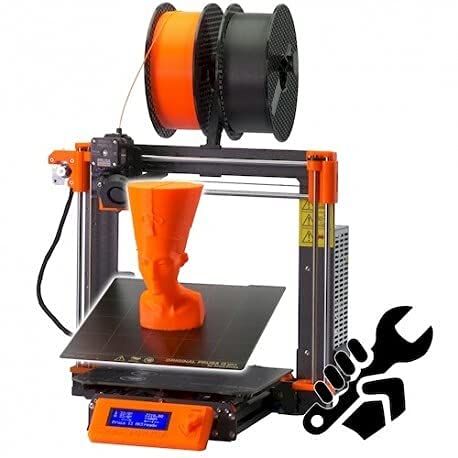
Specifications
| Material | Plastic, Metal |
| Item Weight | 24.03 Pounds |
| Product Dimensions | 19.6 x 21.6 x 15.7 inches |
| Print size | 250 x 210 x 210 mm |
| Filament Diameter | 1.75 mm |
| Max Temperature | 300 °C |
General Descriptions
A 3D printer based on an open-source, open-frame design is the Prusa i3 MK3S+, which follows in the footsteps of its predecessors. With excellent print quality and a set of impressive features, it sets itself apart from other 3D printers.
A 3D printer designed for high-quality printing at an affordable price, the Prusa i3 MK3S+ has been designed to be easy to use. A heated bed is installed on this printer, which ensures that your prints won’t warp and will come out correctly. In addition, the MK3S+ has an auto-leveling function, so you can get started right away.
Finally, the MK3S+ comes with an LCD screen, which makes controlling your printer’s functions a breeze, and it has a sturdy metal structure that ensures prints are accurate every time.
With its neat features, high printing quality, and consistently reliable performance, this 3D printer is a great choice for hobbyists and beginners alike. It is well-supported and easy to use. Professionals may also enjoy it.
2. ANYCUBIC Resin 3D Printer
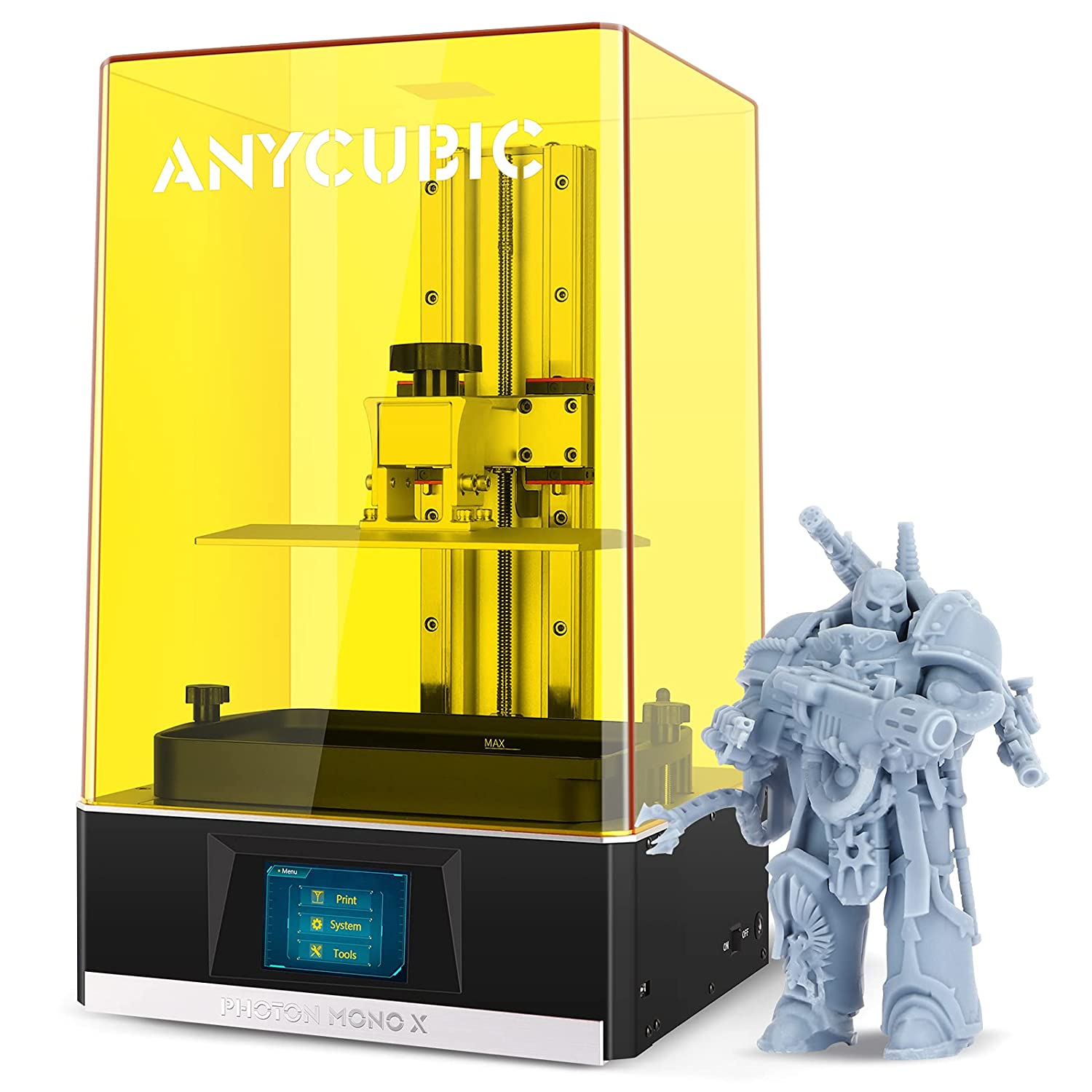
Specifications
| Material | Metal |
| Item Weight | 24.3 Pounds |
| Product Dimensions | 7.55 x 9.84 x 4.72 inches |
| Compatible Material | Resin |
General Descriptions
An 8.9-inch 4K LCD screen and a fast print speed of fewer than 2 seconds guarantee your satisfaction with this printer. Printing speeds can reach 60mm/h at its maximum.
Also, its relatively large size allows you to print several documents simultaneously, saving you a lot of time and enhancing your work productivity. Additionally, ignoring the feature that prevents printing after opening the lid would be a mistake. For those just starting out with the device, this feature provides reassurance and makes printing easier.
With the integrated parallel UV light source, the machine also provides a higher degree of accuracy and stability for better printing results. A UV cooling system is also built into the machine, which combines exclusive heat dissipation channels to maintain stable printing performance. Remote control is also offered with this printer so that you can conveniently monitor your printing progress.
As a final feature of this ANYCUBIC, the dual linear rails on the Z-axis and the elegant nut combination enhance stability and prevent wobbling during the printing program. This results in improved print quality as well. Overall, this printer is convenient and versatile.
3. R QIDI TECHNOLOGY 3D Printer
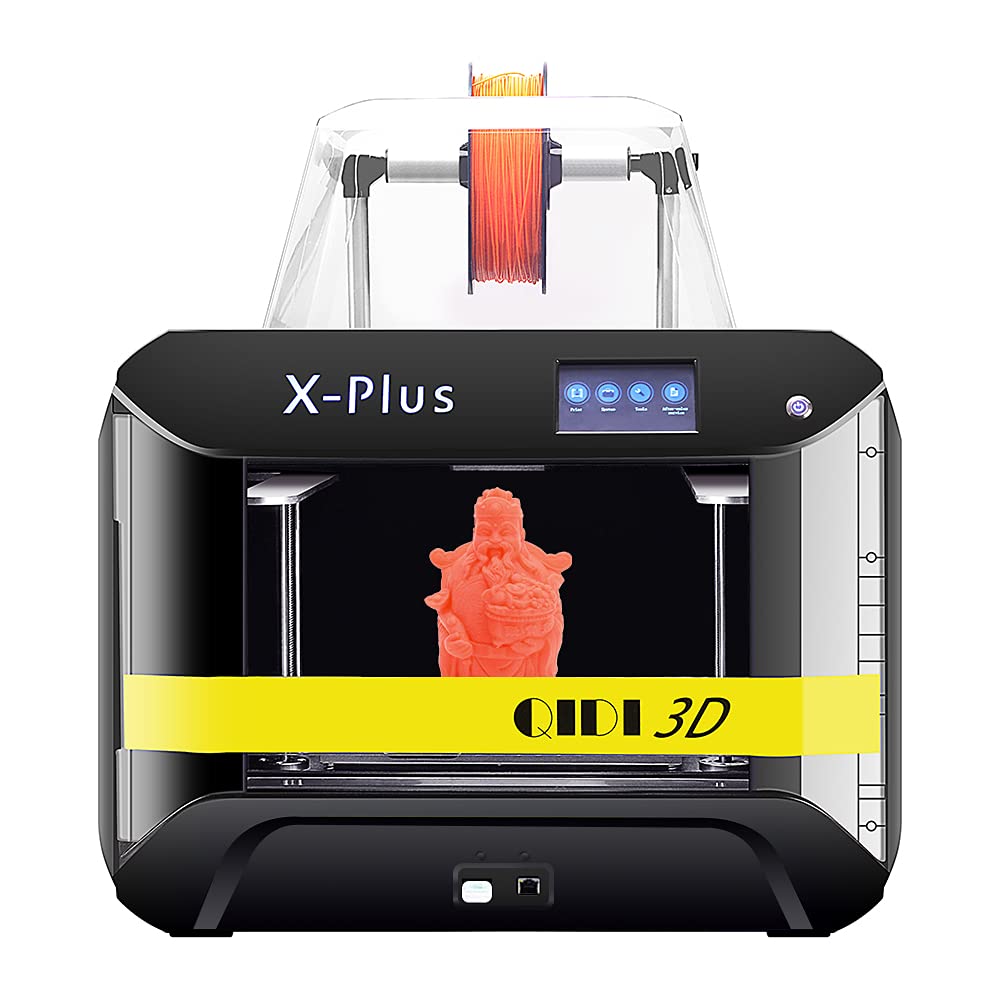
Specifications
| Material | Acrylic |
| Item Weight | 50.7 Pounds |
| Product Dimensions | 580 x 510 x 550 mm |
| Compatible Material | Carbon fiber, Nylon, PETG, TPU, PC, ABS, PLA |
| Print Size | 300 x 250 x 300 mm |
| Print Speed | 30-150 mm/s |
| Nozzle Diameter | 0.4 mm |
| Power | 450 W |
General Descriptions
A plug-and-play FDM printer, the R QIDI X-Plus has the added versatility of a supplementary extruder and an expanded material range. A great customer support system and easily repaired standard parts make it a great choice for most users.
Its semi-enclosed design makes it easy to set up, and it comes with a standard extruder that can be used with PLA, ABS, and TPU. Upon request, a second technical-material extruder is also available free of charge with your purchase, which demonstrates the company’s communication-forward philosophy, and is capable of working with nylon, PC, carbon fiber, etc. This second extruder is swappable instead of supplementary, it is not a dual extruder rig, and it cannot be used in conjunction with the standard extruder.
The technical nozzle, however, makes this machine stand out from cheaper FDMs in the sub-$500 range.
In addition to providing excellent customer service, QIDI offers easy repairs as well. A majority of the parts in this system are standard and easily replaceable, but most of the replacements can also be DIYed with the included tools. With knowledgeable agents available to help troubleshoot issues and send repair parts as needed, QIDI offers exceptional customer service.
In spite of the lack of automatic leveling at this price point, the X-Plus has a reliable and simple quick-leveling system that is semi-automatic. It also features QIDI Print Slicer software, which is free to use with any QIDI system.
In summary, despite the fact that this system might not appeal to hardcore tinkerers, users will find it easy to use and receive good customer support.
4. Digilab 3D20 3D Printer
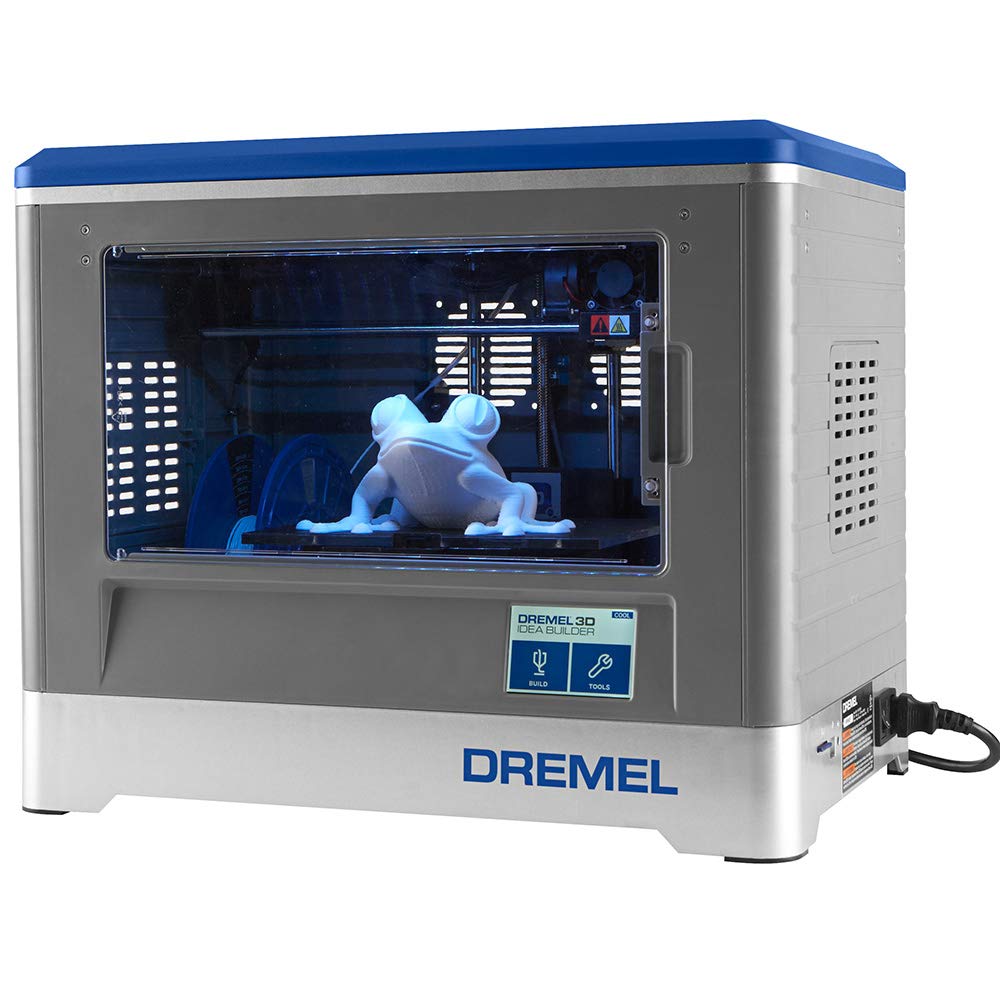
Specifications
| Material | PLA |
| Item Weight | 15.43 Pounds |
| Product Dimensions | 18.5 x 13.39 x 13.78 inches |
| Compatible Material | Polylactic Acid |
| Print Size | 230 x 150 x 140 mm |
| Filament Diameter | 1.75 mm |
| Max Temperature | 230 °C |
General Descriptions
For beginners on a low budget, the Dremel Digilab 3D20 is designed to meet their needs. This machine offers easy-to-use features, safety, and plug-and-play functionality and comes from a trusted brand for less than $500. Educators, students, and hobbyists will find the Dremel 3D20 to be affordable and user-friendly.
With the Digilab 3D20, you get a safe and easy-to-use 3D printer for use around kids, pets, and small animals due to its closed frame. It is easy to use, does not require extensive calibration, and works very well as-is.
You’re only able to use PLA filament with the 3D20 since it has a non-heated print bed. And because Dremel’s PLA is the only filament the printer supports, you’re likely to spend more than you would on a printer from another manufacturer.
The 3D20 offers all of the essentials you need to get started with 3D printing. It is a great machine to introduce your children to 3D printing and meets all of the primary requirements.
5. BIBO 3D Printer
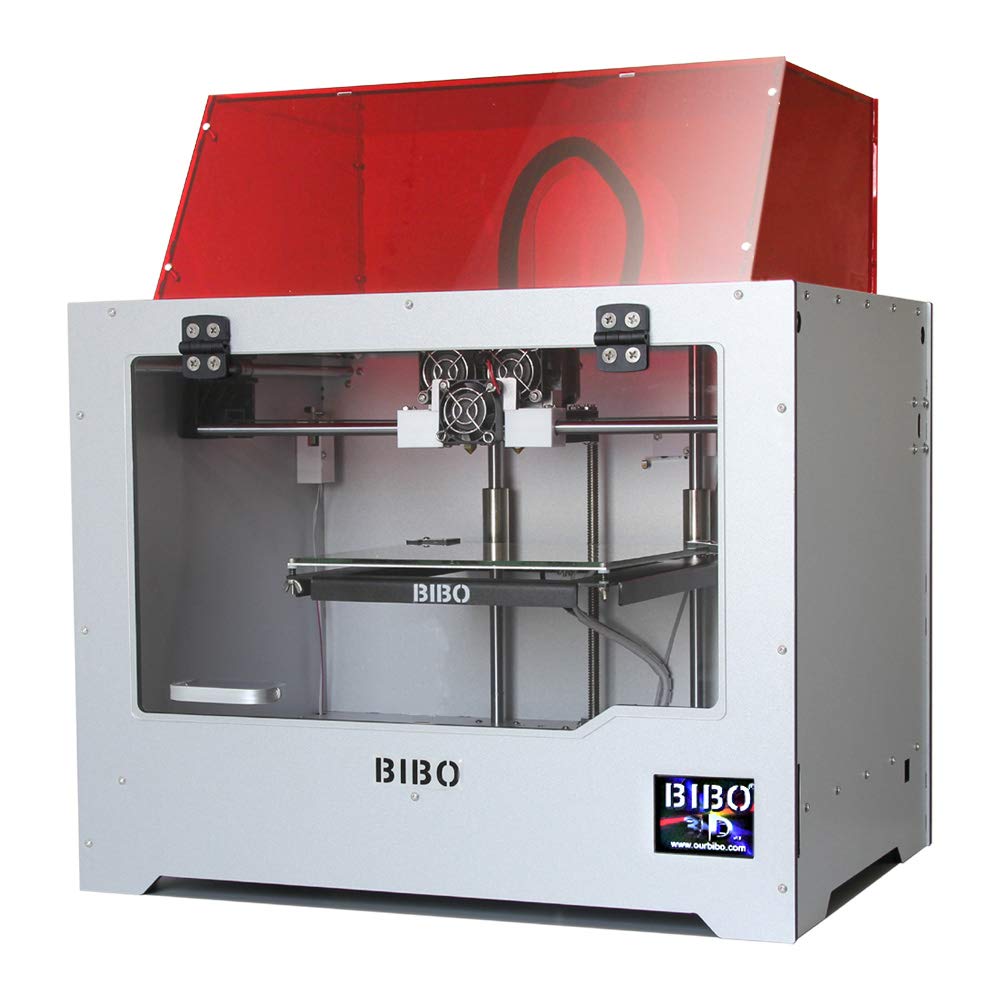
Specifications
| Material | Aluminum, Glass, Polylactic Acid, Plastic, Acrylonitrile Butadiene Styrene, Polycarbonate, Acrylic |
| Item Weight | 40.19 Pounds |
| Product Dimensions | 21.46 x 19.88 x 17.02 inches |
| Compatible Material | Acrylonitrile Butadiene Styrene, Plastic, Acrylic, Polycarbonate, Thermoplastic Polyurethane, High Impact Polystyrene, Polylactic Acid, Polyvinyl Alcohol |
General Descriptions
This printer is made of a 6mm thick aluminum composite frame. BIBO is a printer with a sturdy, stable, and strong construction.
Additionally, you can keep an eye on the progress of the project using an acrylic window mounted on the machine. This can be removed whenever you want, but it is not recommended that you do so too often.
A dual extruder design also ensures excellent print quality and a unique color printing capability. Furthermore, with speeds ranging from 80 to 90mm/s, you will save a lot of time with BIBO.
Direct drive extrusion technology prevents filament in the drive tube from bending or warping, which is an additional advantage that many users like about this machine.
This machine has integrated two fans in both the front and back of the device. These fans ensure that the print chamber stays cool while maximizing the printer’s lifespan.
The last thing we would like to highlight is the fact that this printer is Wi-Fi compatible. Because of this, you can control it remotely from your smartphone or tablet. Further, the machine can be connected via SD cards, USB cables, or USB flash drives.
There is no doubt that this machine is one of the safest on the market.
6. Official Creality Ender 3 S1 3D Printer
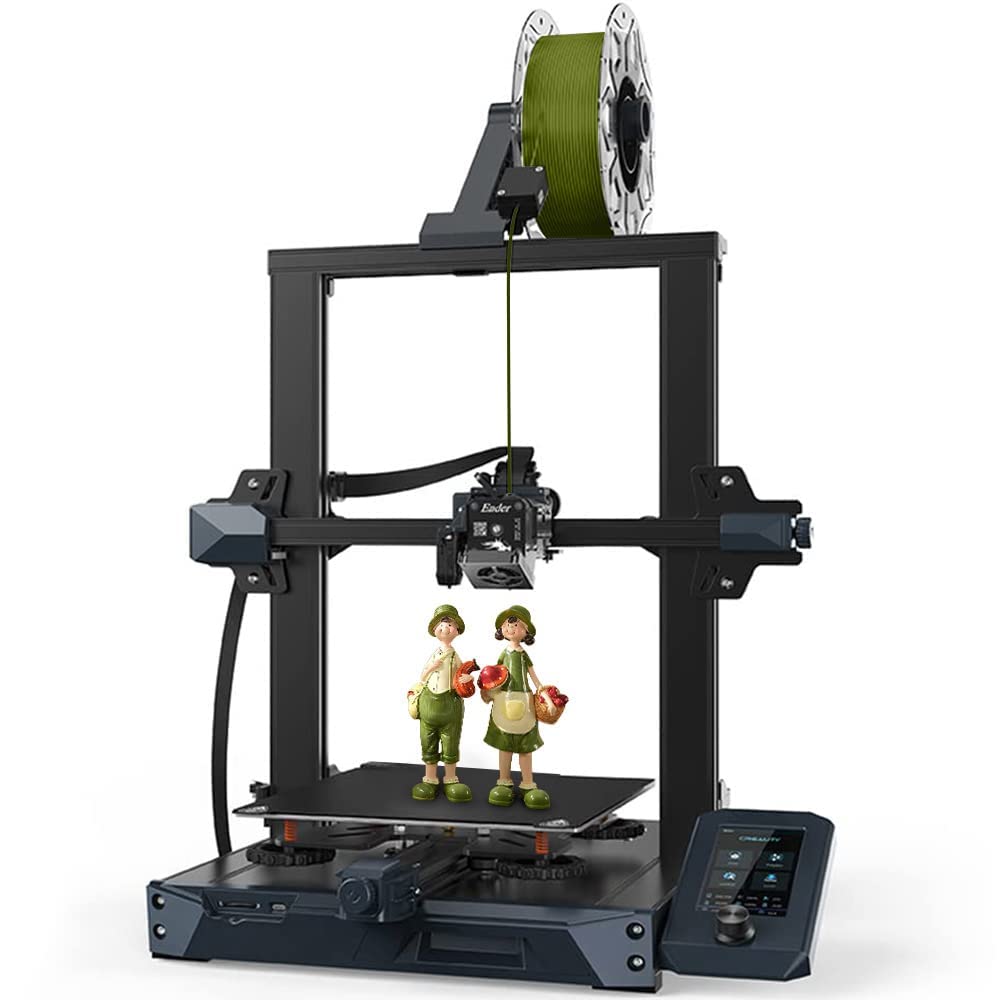
Specifications
| Material | Metal |
| Item Weight | 20.1 Pounds |
| Product Dimensions | 8.6 x 8.6 x 10.2 inches |
| Compatible Material | Acrylonitrile Butadiene Styrene, Polyethylene Terephthalate Glycol, Thermoplastic Polyurethane, Alloy Steel, Polylactic Acid |
| Power Consumption | 350 Watts |
General Descriptions
We recommend the Creality Ender-3 S1 as an excellent 3D printer for under 500, even if you have a bigger budget. The Ender series from Creality is the most recognizable series for beginners, along with Prusa. With an extruder that reaches 500 degrees Fahrenheit, it’s also not too restrictive in comparison to other systems that cost twice as much. It’s also open-source and expandable. The program won’t cover more technical material, but it does a better job than most, and if you’re a newbie, that might not matter to you.
A 16-point auto-leveling system on the S1 ensures that your print bed is always up to the challenge. A spring steel plate is removable, as is a power-loss recovery feature, and a filament sensor is also included. With its dual motor design, it delivers solid precision.
Despite lacking some of the features of more expensive 3D printers, the S1 is an exceptional hobbyist’s 3D printer that can do a lot. The S1 is a great foundation that can be extended significantly with mods.
7. FlashForge 3D Printer
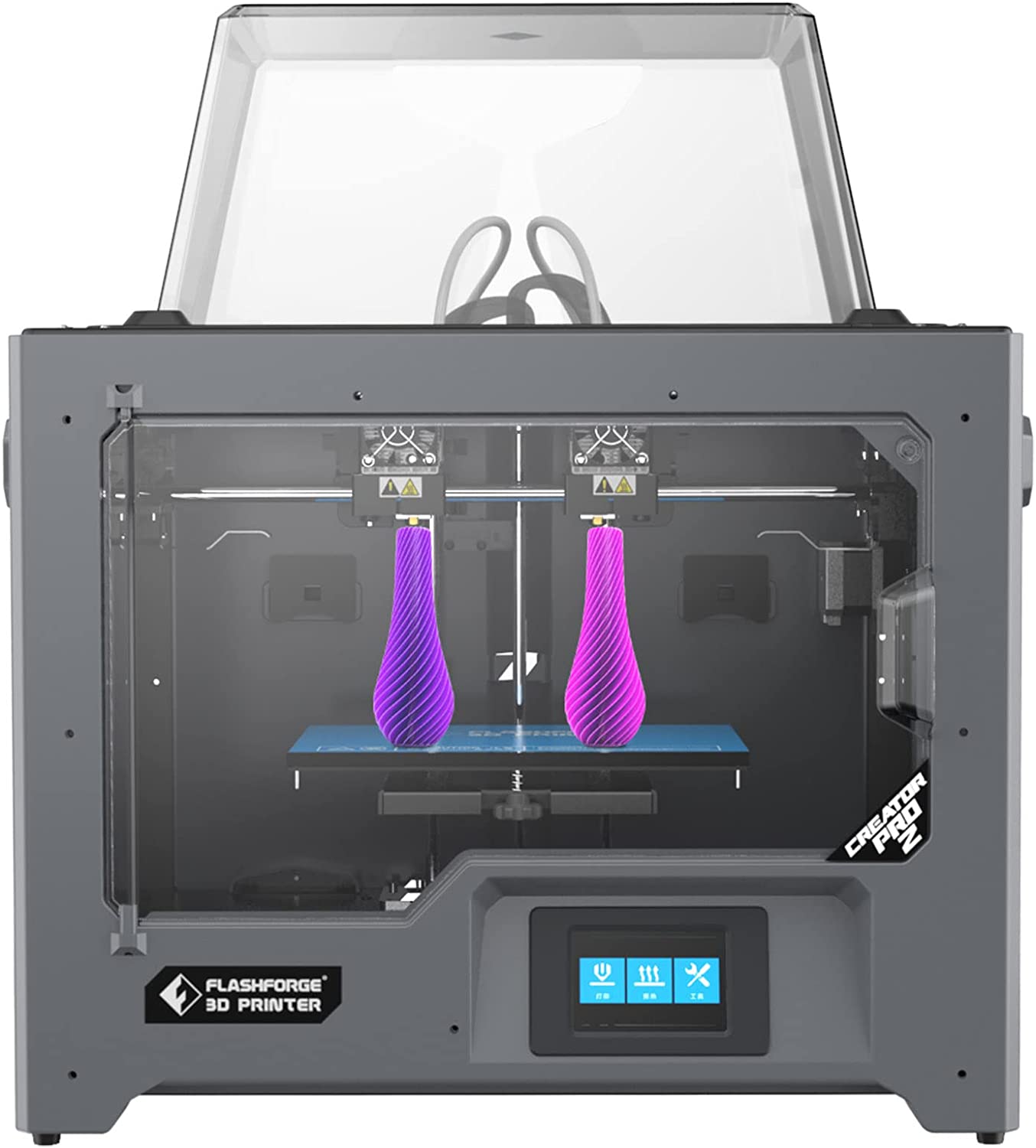
Specifications
| Material | Polylactic Acid, Acrylonitrile Butadiene Styrene |
| Item Weight | 33.07 lbs |
| Product Dimensions | 21.6 x 15.7 x 18.8 inches |
| Compatible Material | Polyethylene Terephthalate Glycol, Polylactic Acid, Acrylonitrile Butadiene Styrene, Thermoplastic Polyurethane |
| Filament Diameter | 1.75 mm |
| Print Size | 200 x 148 x 150 mm |
General Descriptions
It comes with an Independent Dual Extruder (IDEX) system, which is unusual for a 3D printer below $1000. With it, you can print in 3D modes such as mirror, duplicate, and multi-material. In addition, IDEX offers the option of 3D printing with soluble supports, which are ideal when you want to 3D print complicated designs with intricate details.
With its partially enclosed design and removable top cover, the Creator Pro 2 has a robust build quality and an intuitive touchscreen, making it easy to use various functions. ABS filaments, as well as many other high-performance filaments, can be printed in its heating chamber.
Whether you are seeking a multi-material or mass-manufacturing 3D printer, the Pro 2 is an excellent choice. It is suitable for professionals, STEM applications, or hobbyists seeking dual-color or multi-material printing.
8. Creality CR10 S5
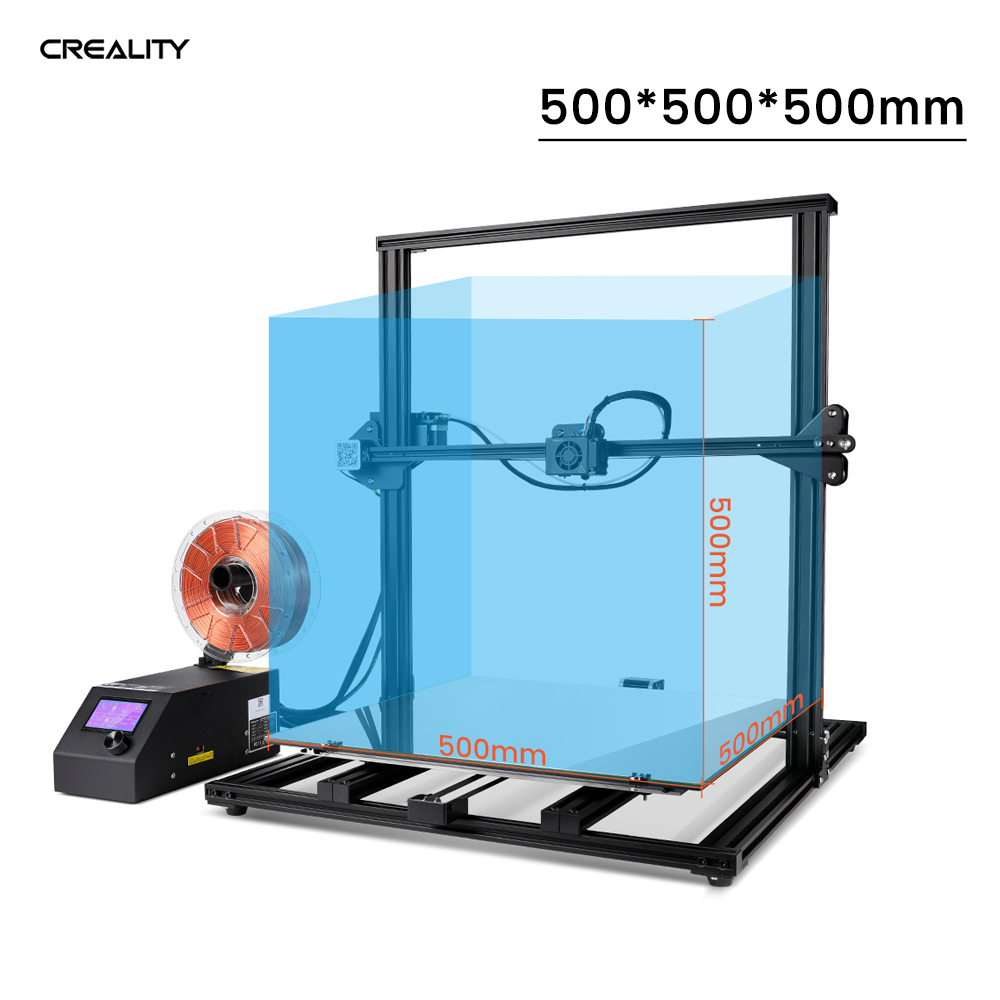
Specifications
| Print size | 500 x 500 x 500 mm |
| Bed leveling | Manual |
| Heated bed | Yes |
| Supported slicers | PrusaSlicer, Cura, Simplify3D, etc. |
| Filament diameter | 1.75 mm |
| Max hotend temperature | 260 °C |
General Descriptions
The CR10 series from Creality is renowned for having vast construction spaces at reasonable rates. With one of the largest construction volumes (500 x 500 x 500 mm) in the sub-$1000 market class, the CR-10 S5 goes a step further.
A heated print bed, a filament detector, a power recovery system, and a twin screw Z-axis for greater stability are further characteristics of the CR-10 S5, in addition to its amazing build volume. With the heated print bed, you can print with ABS, PETG, and other high-tech materials. Safety features like the filament run-out detector and resume printing help you avoid botched prints.
The 3D printers from Creality may not be the most dependable, but they are quite affordable. This is also true of the CR10-S5. If you want to 3D print helmets, costume armor, swords, video game environments, and other cosplay props, you have that option.
9. Elegoo Saturn
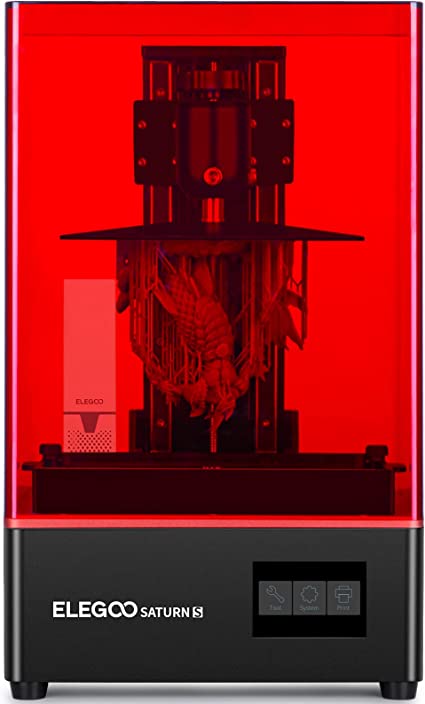
Specifications
| Print size | 192 x 120 x 200 mm |
| Bed leveling | Semi-automatic |
| Heated bed | No |
| Supported slicers | Chitubox, Lychee |
General Descriptions
The Elegoo Saturn is unquestionably the best resin 3D printer under $1,000 and a strong rival to the Anycubic Mono X. The Saturn’s characteristics resemble those of the Mono X on the outside. However, there are a few minute variations between the two.
To begin with, Elegoo has a better history of customer assistance than Anycubic. Therefore, the Saturn is a better choice down the road if you want any spare parts or assistance with troubleshooting.
On the other side, you are forced to use the Saturn’s own Chitubox slicer if you update the firmware to the most recent version. More slicers, including Lychee, Chitubox, and Anycubic’s proprietary slicer, are compatible with the MonoX.
The Saturn shares the same 4K monochrome LCD screen with UV matrix and provides a similar XY resolution of 50 microns in terms of specifications. It has an all-aluminum construction and a robust resin vat that is built to last. The 3D printer’s UV lights’ lifespan is also extended by the UV cooling fans.
The Elegoo Saturn is a fantastic 3D printer that operates flawlessly. It makes an excellent first resin 3D printer for novices while also matching the demands of an expert hobbyist user.
10. MatterHacker Pulse XE

Specifications
| Print size | 250 x 220 x 215 mm |
| Bed leveling | Automatic |
| Heated bed | Yes |
| Supported slicers | Mattercontrol, Cura, PrusaSlicer |
| Filament diameter | 1.75 mm |
| Max hotend temperature | 300°C |
General Descriptions
A 3D printer in the Prusa i3 mold, the MatterHacker Pulse XE is intended for use by professionals and other high-end 3D printing applications.
A dependable Bondtech extruder and an all-metal, 300°C-capable E3D V6 print head are used in the Pulse XE. Additionally, it has a LayerLock Garolite print bed that was created especially for printing engineering-grade materials like carbon fiber-filled filament and Nylon, Nylon X, and Nylon. Consequently, it shouldn’t come as a surprise that this printer topped our list of the best nylon 3D printers.
You may now 3D print with abrasive materials like steel-fill and glow-in-the-dark filament thanks to the hot end’s hardened steel nozzle, which extends the range of compatible materials. A 32-bit 3D printer motherboard for silent printing, a Mosquito hot end that can reach up to 500°C, and a high resolution LCD screen are just a few of the modifications that Matterhackers provides. These additions can help the Pulse XE’s capabilities.
The Pulse XE is a fantastic addition to your workflow if the majority of your work involves utilizing high-end materials and you require a 3D printer capable of producing good print quality. In comparison to its rivals, it is the finest 3D printer under $1,000 in terms of material compatibility.
Download Best 3d Printer for Under $1000 in 2024 PDF
You can download a PDF version of the article by clicking on the link below.
linquip.com-The 10 Best 3D Printer for Under 1000 in 2024
Watch Videos about Best 3d Printer for Under $1000 in 2024
For more information about Best 3d Printer for Under $1000 in 2024, watch the following video.
Buy Equipment or Ask for a Service
By using Linquip RFQ Service, you can expect to receive quotations from various suppliers across multiple industries and regions.
Click Here to Request a Quotation From Suppliers and Service Providers
Read More on Linquip
- The 10 Best 3D Printer for Under $500
- The 10 Best Industrial 3D Printer
- The 10 Best Large 3D Printer
- The 10 Best FDM 3d Printer + Buying Guide
- What Is 3D Printing and How Does It Work? + Applications
- 10 Types of 3D Printing: A Comprehensive Guide
- The 9 Best 3D Printer for Under $300
- The 5 Best Chisel Sets for Woodworking + Buying Guide
- The 6 Best Dual Action Polishers
- The 10 Best Tool Box Organizer + Buying Guide
- The 7 Best Jigsaw + Buying Guide
- The 10 Best Drywall Anchors + Buying Guide
- The 10 Best Box Cutter/Utility Knife Options
- The 8 Best Soldering Irons + Buying Guide
- The 9 Best Commercial Patio Heaters + Buying Guide
- The 10 Best Glues for Metal + Tips for Choosing
- The 8 Best Cordless Drills + Buying Guide
- The 8 Best Paint Sprayers + Buying Guide
- The 10 Best Angle Grinders
- The 10 Best Laser Measures + Guide for Selecting

